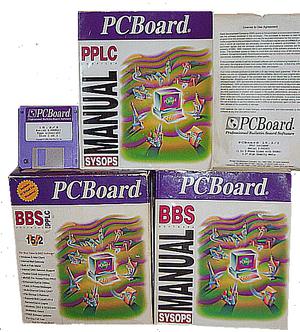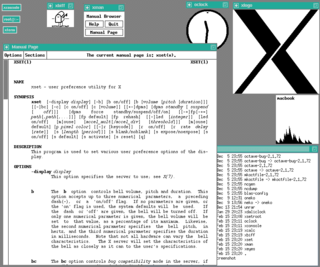
A bulletin board system (BBS), also called a computer bulletin board service (CBBS), is a computer server running software that allows users to connect to the system using a terminal program. Once logged in, the user performs functions such as uploading and downloading software and data, reading news and bulletins, and exchanging messages with other users through public message boards and sometimes via direct chatting. In the early 1980s, message networks such as FidoNet were developed to provide services such as NetMail, which is similar to internet-based email.
FidoNet is a worldwide computer network that is used for communication between bulletin board systems (BBSes). It uses a store-and-forward system to exchange private (email) and public (forum) messages between the BBSes in the network, as well as other files and protocols in some cases.
In a bulletin board system (BBS), a door is an interface between the BBS software and an external application. The term is also used to refer to the external application, a computer program that runs outside of the main bulletin board program. Sometimes called external programs, doors are the most common way to add games, utilities, and other extensions to BBSes. Because BBSes typically depended on the telephone system, BBSes and door programs tended to be local in nature, unlike modern Internet games and applications.
Synchronet is a multiplatform BBS software package, with current ports for Microsoft Windows, Linux, and BSD variants. Past versions also ran on MS-DOS and OS/2, but support for those platforms were dropped in version 3.0.
ISCABBS, also known as ISCA, is a computer bulletin board system ("BBS"), formerly based at the University of Iowa. "Daves' own version of Citadel" (DOC), an early branch of the Citadel/UX BBS software, was developed to run ISCA. Like most Citadels, the focus is almost entirely on conversation among users.
WWIV was a brand of bulletin board system software popular from the late 1980s through the mid-1990s. The modifiable source code allowed a sysop to customize the main BBS program for their particular needs and aesthetics. WWIV also allowed tens of thousands of BBSes to link together, forming a worldwide proprietary computer network, the WWIVnet, similar to FidoNet.

PCBoard (PCB) was a bulletin board system (BBS) application first introduced for DOS in 1983 by Clark Development Company. Clark Development was founded by Fred Clark. PCBoard was one of the first commercial BBS packages for DOS systems, and was considered one of the "high end" packages during the rapid expansion of BBS systems in the early 1990s. Like many BBS companies, the rise of the Internet starting around 1994 led to serious downturns in fortunes, and Clark Development went bankrupt in 1997. Most PCB sales were of two-line licenses; additional line licenses were also available.

The Major BBS was bulletin board software developed between 1986 and 1999 by Galacticomm. In 1995 it was renamed Worldgroup Server and bundled with a user client interface program named Worldgroup Manager for Microsoft Windows. Originally DOS-based, two of the versions were also available as a Unix-based edition, and the last versions were also available for Windows NT-based servers.

Punter is a protocol for file transfer developed in the 1980s by Steve Punter. There are various types of Punter such as PET Transfer Protocol (PTP), C1 and C2.
Pyroto Mountain is an online game based on answering trivia and skill-testing questions. It was originally developed to run as a stand-alone bulletin board system (BBS), later as a BBS door, and more recently as a web application.

In computing, a shell is a computer program that exposes an operating system's services to a human user or other programs. In general, operating system shells use either a command-line interface (CLI) or graphical user interface (GUI), depending on a computer's role and particular operation. It is named a shell because it is the outermost layer around the operating system.
Celerity BBS was a descendant of the freely distributed source of TCS BBS 1.43, and ultimately nearly completely rewritten.
BiModem was one of the last file transfer protocols developed for use in bulletin board systems. It was created by Erik Labs, and was revolutionary for its day.
The JAM Message Base Format was one of the most popular file formats of message bases on DOS-based BBSes in the 1990s. JAM stands for "Joaquim-Andrew-Mats" after the original authors of the API, Joaquim Homrighausen, Andrew Milner, Mats Birch, and Mats Wallin. Joaquim was the author of FrontDoor, a DOS-based FidoNet-compatible mailer. Andrew was the author of RemoteAccess, a popular DOS-based Bulletin Board System. JAM was originally released in 1993 in C, however the most popular implementation was Mark May's "MK Source for Msg Access" written in Pascal which also saw its initial release in 1993.
ASCII Express, also known as AE, is a telecommunications software developed specifically for the Apple II personal computers. Throughout the 1980s, ASCII Express garnered a reputation as the preferred programme among telecommunications enthusiasts and users. Its functionality and compatibility with the Apple II made it a staple in the early computer communications era.

Net-Works II is a bulletin board system written by Nick Naimo for Apple II microcomputers. It was originally published in the early 1980s. For a time it was the most popular bulletin board system software for the Apple II, out of the dozen or so released.
There are several notable bulletin board systems (BBS) for the TI-99/4A home computer.
The Big Electric Cat, named for an Adrian Belew song, was a public access computer system in New York City in the late 1980s, known on Usenet as node dasys1.
Blue Board is a bulletin board system software created by Martin Sikes (1968–2007) for the Commodore 64 in the 1980s in Vancouver, British Columbia, Canada, and sold worldwide. Due to optimized code and memory allocation, Blue Board boasted very fast performance for a BBS on that hardware platform. In fact, Blue Board was faster than most if not all BBSs run on 8-bit computers. This speed combined with its use of the ASCII character set and XModem file transfer protocol rather than PETSCII and the Commodore-specific Punter protocol sometimes led users to believe that they were calling a BBS running on a much larger and faster computer.
GT Power is a bulletin board system (BBS) and dial-up telecommunications/terminal application for MS-DOS. It was first introduced in the 1980s by P & M Software, founded by Paul Meiners. GT Power can be used both to host a BBS as well as to connect to other BBS systems via its full-featured dial-up "terminal mode". GT Power was a shareware package that required a registration fee in order to access its proprietary network mail transport/handling software and, by default, the GT Power Network. The software is distributed in two "flavors": a terminal-only version, nicknamed GTO, and the full-featured host and terminal version.






